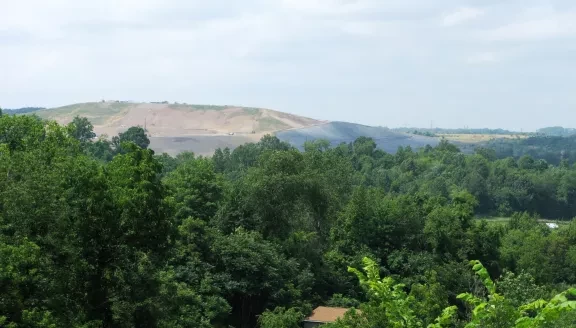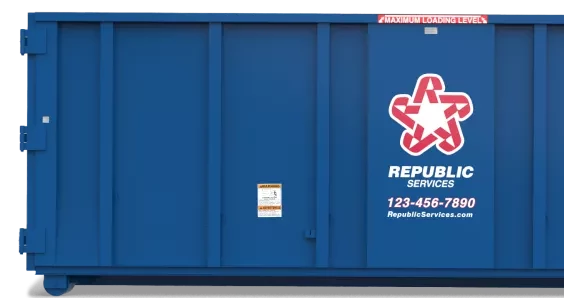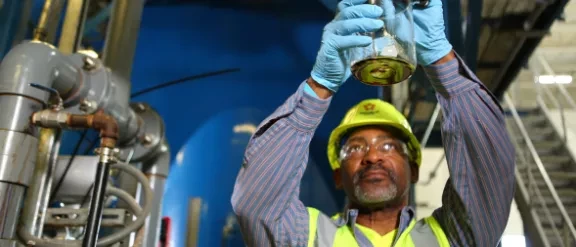
Landfills Engineered for Sustainability
Customers count on Republic Services to responsibly handle the materials they no longer need through services and solutions that solve today's environmental challenges. Our 200+ modern landfills provide safe and effective disposal for materials that can't be reused or recycled.
Changing Perceptions and Functions
The role of modern landfills
Republic Services is entrusted to responsibly manage solid waste for thousands of communities and millions of customers across the country through our modern landfills. Today's landfills are highly engineered regenerative systems designed to maximize the decomposition of waste, minimize environmental impacts and, at many sites, generate renewable energy.
We're upending traditional ideas of what's possible at landfills by applying science, technology and innovation. We're working to shrink the carbon footprint of our landfills by reducing emissions, while protecting biodiversity and preserving natural resources.
How a regenerative landfill works
1
Waste Collection
Our fleet of 17,000+ trucks make an average of 5M pickups daily from businesses and homes.

Once trucks are full, some head straight to the landfill. Others go to a transfer station.

Americans generate 4.9 lbs. of waste per person, per day. About 1/3 of that is recycled or composted. The rest heads to landfills.1
Sending less to the landfill
Recycling
- We’re committed to increasing recovery and circularity of valuable materials by 40% by 2030.
- Recycling reduces the need for the extraction, processing, and transportation of virgin materials.
- The recycling process (link to that process diagram)
Food waste diversion
- We’re exploring innovative ways to keep organic food waste out of landfills.
- Organics recycling (link to that process diagram)

2
Transfer
Waste from multiple trucks is consolidated at a transfer station. Consolidation onto larger trucks increases efficiency and reduces traffic.
The larger trucks haul waste from the transfer station to a modern regenerative landfill
3
Regenerative Landfill
A landfill is much more than a hole in the ground. Landfills are constructed with a series of sophisticated, engineered layers to help protect the environment as waste decomposes.

Landfills are divided into sections called cells.
Cells enable waste to be placed in one area at a time. Waste is compacted to maximize space before moving to the next cell. In the evening, cells are covered to reduce litter and rainwater infiltration, and keep birds and animals away.

- vegetation
- topsoil
- protective cover soil
- drainage net
- geomembrane
- compacted clay liner
- compacted waste
- drainage layer
- collection pipe
- composite drainage kit
- geomembrane
- compacted cohesive soil
- drainage layer
Waste is compacted and covered daily to limit wind-blown debris and odors and to create a stable, engineered hill.
An impermeable layer of synthetic material lines the entire landfill.
A complex drainage system prevents water that has come into contact with waste from mixing with ground and/or surface water.
Gas collection systems harness and remove gas from the landfill for alternative use.
87% of our landfill acreage is covered by gas wells.
Where a landfill gas-to-energy (LFGTE) system is not feasible, landfill gas is thermally oxidized through flares, reducing its global warming potential by 96%.

Compacted sections are covered with an engineered closure system. This helps mitigate:
Rainwater infiltration
Fugitive greenhouse gas emissions
When a landfill closes, we continue to manage it for 30 years
Some closed landfill sites are now home to solar energy fields. We host 8 solar panel projects across the U.S. (on top of veg layer)
What was previously an active landfill now sits in its natural surroundings. (veg layer)
We lay down a protective layer of cover soil, topsoil and vegetation. (topsoil/cover soil layer)
A synthetic liner provides another layer of protection. (geomembrane layer)
The landfill is encapsulated with a layer of compacted clay more than 2’ thick. (clay layer)
Leachate
Leachate is formed when rainwater filters through the waste in a landfill. As it contacts the buried waste, the water draws out (or leaches) chemicals and other components from the waste. Leachate is collected through a series of perforated pipes and pumped out of the landfill. It can be pretreated on-site and reused at the landfill or transported. If it's not reused on-site, it's sent to a wastewater treatment facility for processing.

Phytoremediation
Some species of vegetation are naturally good at absorbing metals and contaminants from wastewater. At one site, we planted 1,700 hybrid poplar trees, which treat 1,000 gallons of water per day.

4
Harnessing Energy
Biogas produced by waste decomposition is captured
LFGTE Process

Biogas is processed and converted into renewable energy:
- Renewable natural gas (RNG)
- Electricity
- Thermal energy
Our renewable energy projects
- 65 active LFGTE sites
- 40 more in development with bp
RNG powers 20% of our fleet.
Our landfills produce enough energy to power 310,000 homes per year.
Republic Services landfills defy expectations. Our landfills aren't just disposal sites—they are places where we put new ideas into action. Engineered and managed with sustainability at the forefront, landfills can be places that allow us to both manage our customers' waste and prioritize our planet.
1United States Environmental Protection Agency, “National Overview: Facts and Figures on Materials, Wastes and Recycling,” December 3, 2022.
https://www.epa.gov/facts-and-figures-about-materials-waste-and-recycling/national-overview-facts-and-figures-materials. Accessed November 2023.
*On a combined basis, 2017 baseline year. Key materials include paper, cardboard, metals, plastics and organics.